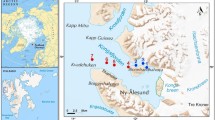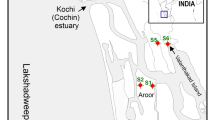Abstract
The vertical distribution of meiofauna in the sediments ofAvicennia marina,Bruguiera gymnorrhiza,Ceriops tagal,Rhizophora mucronata andSonneratia alba at Gazi Bay (Kenya), is described. Seventeen taxa were observed, with highest densities in the sediments ofBruguiera (6707 ind. 10 cm−2), followed byRhizophora (3998 ind. 10 cm−2),Avicennia (3442 ind. 10 cm−2),Sonneratia (2889 ind. 10 cm−2) andCeriops (1976 ind. 10 cm−2). Nematodes accounted for up to 95% of total densities; other common taxa were copepods, turbellarians, oligochaetes, polychaetes, ostracods and rotifers. High densities occurred to about 20 cm depth in the sediment. EspeciallyCeriops sediments show still high densities of nematodes (342 ind. 10 cm−2) and copepods (11 ind. 10 cm−2) in the deepest layer (15–22 cm). Particle size and oxygen conditions were major factors influencing meiobenthic distribution;Uca burrows had a major impact on distribution and abundance of meiofauna.
Similar content being viewed by others
References
Alongi, D. M., 1987a. Intertidal zonation and seasonality of meiobenthos in tropical mangrove estuaries. Mar. Biol. 95: 447–458.
Alongi, D. M., 1987b. Inter-estuary variations and intertidal zonation of free-living nematode communities in tropical mangrove systems. Mar. Ecol. Prog. Ser. 40: 103–114.
Alongi, D. M., K. G. Boto & F. Tirendi, 1989. Effects of exported mangrove litter on bacterial productivity and dissolved organic carbon fluxes in adjacent tropical nearshore sediments. Mar. Ecol. Prog. Ser. 56: 133–144.
Andersen, F. O. & B. T. Hargrave, 1984. Effects ofSpartina detritus enrichment on aerobic/anaerobic benthic metabolism in an intertidal sediment. Mar. Ecol. Prog. Ser. 16: 161–171.
Benner, R. & R. E. Hudson, 1985. Microbial degradation of the leachable and lignocellulosic components of leaves and wood fromRhizophora mangle in a tropical mangrove swamp. Mar. Ecol. Prog. Ser. 23: 221–230.
Boaden, P. J. S., 1975. Anaerobiosis, meiofauna and early metazoan evolution. Zool. Scr. 4: 21–4.
Boaden, P. J. S. & R. Seed, 1985. An introduction to Coastal Ecology, Chapter 7, Blackie USA: Chapman & Hall, N. Y., 218 pp.
Boto, K. G., J. S. Bunt & J. T. Wellington, 1984. Variations in mangrove forest productivity in northern Australia and Papua New Guinea. Estuar. coast. Shelf Sci. 19: 321–329.
Buchanan, J. B., 1984. Sediment analysis. In N. A. Holme & McIntyre (eds), Methods for the Study of Marine Benthos. IBP No 16, 2nd edn. Blackwell Scientific Publications, 387 pp.
Camilleri, J., 1989. Leaf choice by crustaceans in a mangrove forest in Queensland. Mar. Biol. 102: 453–459.
Coull, B. C., 1988. Ecology of the marine meiofauna. In R. P. Higgins & H. Thiel (eds), Introduction to the study of meiofauna: 18–38.
Cundell, A. M., M. S. Brown, R. Stanford & R. Mitchell, 1979. Microbial degradation ofRhizophora mangle leaves immersed in the sea. Estuar. coast. mar. Sci. 9: 281–286.
Decraemer, W. & A. Coomans, 1978. Scientific report on the belgian expedition to the Great Barrier Reef in 1967. Nematodes XII. Ecological Notes on the Nematode Fauna in and around Lizard Island. Aust. J. mar. Freshwat. Res. 29: 497–508.
DePatra, K. D. & L. A. Levin, 1989. Evidence of the passive deposition of meiofauna into fiddler crab burrows. J. exp. mar. Biol. Ecol. 125: 173–192.
Dye, A. H., 1983a. Vertical and horizontal distribution of meiofauna in mangrove sediments in Transkei, Southern Africa. Estuar. coast. Shelf Sci. 16: 591–598.
Dye, A. H., 1983b. Composition and seasonal fluctuations on meiofauna in a southern african mangrove estuary. Mar. Biol. 73: 165–177.
Dye, A. H. & T. A. Lasiak, 1986. Microbenthos, meiobenthos and fiddler crabs: trophic interactions in a typical mangrove sediment. Mar. Ecol. Prog. Ser. 32: 259–264.
Gallin, E., E. Coppejans & H. Beeckman, 1989. The mangrove vegetation of Gazi Bay (Kenya). Bull. Soc. r. Bot. Belg. 122: 197–207.
Gerlach, S. A., 1958. Die Mangroveregion tropischer Küsten als Lebensraum. Z. Morph. Ökol. Tiere 46: 636–730.
Giere, O., A. Eleftheriou & D. J. Murison, 1988. Abiotic factors. In R. P. Higgins & H. Thiel (eds), Introduction to the Study of Meiofauna: 61–78.
Heip, C., M. Vincx & G. Vranken, 1985. The ecology of marine nematodes. Oceanogr. Mar. Biol. ann. Rev. 23: 399–489.
Herrera, A. & R. del Valle, 1980. Caracteristicas de la meiofauna bentósica en la laguna y zona costera de Guayabal en relación con el grado de contaminacion. Ciencias Biológicas 5: 29–45.
Hodda, M. & W. L. Nicholas, 1985. Meiofauna associated with mangroves in the Hunter River Estuary and Fullerton Cove, south-eastern Australia. Aust. J. mar. Freshwat. Res. 36: 41–50.
Lalana-Rueda, R. & F. Gosselck, 1986. Investigations of the Benthos of Mangrove Coastal Lagoons in Southern Cuba. Int. Revue ges. Hydrobiol. 71: 779–794.
Lugo, E. L. & S. C. Snedaker, 1974. The ecology of mangroves. Annu. Rev. Ecol. Syst. 5: 39–64.
McIntyre, A. D. & R. M. Warwick, 1984. Meiofauna techniques. In N. A. Holme & McIntyre (eds), Methods for the study of marine benthos, Blackwell Scientific Publications: 217–244.
Nicholas, W. L., J. A. Elek, A. C. Stewart & T. G. Marples, 1991. The nematode fauna of a temperate Australian mangrove mudflat; its population density, diversity and distribution. Hydrobiologia 209: 13–27.
Odum, W. E., 1988. Comparative ecology on tidal fresh water and salt marshes. Annu. Rev. Ecol. Syst. 19: 147–176.
Okemwa, E. N., R. K. Ruwa & P. Polk, 1986. The autecology of the edible oysterCrassostrea cucullata Born, 1778: size related vertical distribution at Mkomani, Mombasa. Kenya J. Sci. B 7: 9–14.
Robertson, A. I., 1986. Leaf-burying crabs: their influence on energy flow and export from mixed mangrove forests (Rhizophora spp.) in northeastern Australia. J. exp. mar. Biol. Ecol. 102: 237–248.
Ruwa, R. K., 1990. The effects of habitat complexities created by mangroves on macrofaunal composition in brackishwater intertidal zones at the Kenyan coast. Discovery and Innovation 2: 49–55.
Ruwa, R. K. & P. Polk, 1986. Short communication. Additional information on mangrove distribution in Kenya: some observations and remarks. Kenya J. Sci. B 7: 41–45.
Steinke, T. D. & C. J. Ward, 1988. Litter production by mangroves. II. St. Lucia and Richards Bay. S. Afr. J. Bot. 54: 445–454.
Twilley, R. R., A. E. Snedaker & C. Pattersen-Zucca, 1986. Litter production and turnover in basin mangrove forests in southwest Florida. Ecology 67: 670–683.
Wieser, W., J. Ott, F. Schiemer & E. Gnaiger, 1974. An ecophysiological study of some meiofauna inhabiting a sandy beach at Bermuda. Mar. Biol. 26: 235–249.
Woodroffe, C. D., 1987. Pacific Island mangroves: distribution and environmental settings. Pacific Science 41: 1–4.
Author information
Authors and Affiliations
Rights and permissions
About this article
Cite this article
Vanhove, S., Vincx, M., Van Gansbeke, D. et al. The meiobenthos of five mangrove vegetation types in Gazi Bay, Kenya. Hydrobiologia 247, 99–108 (1992). https://doi.org/10.1007/BF00008208
Issue Date:
DOI: https://doi.org/10.1007/BF00008208




